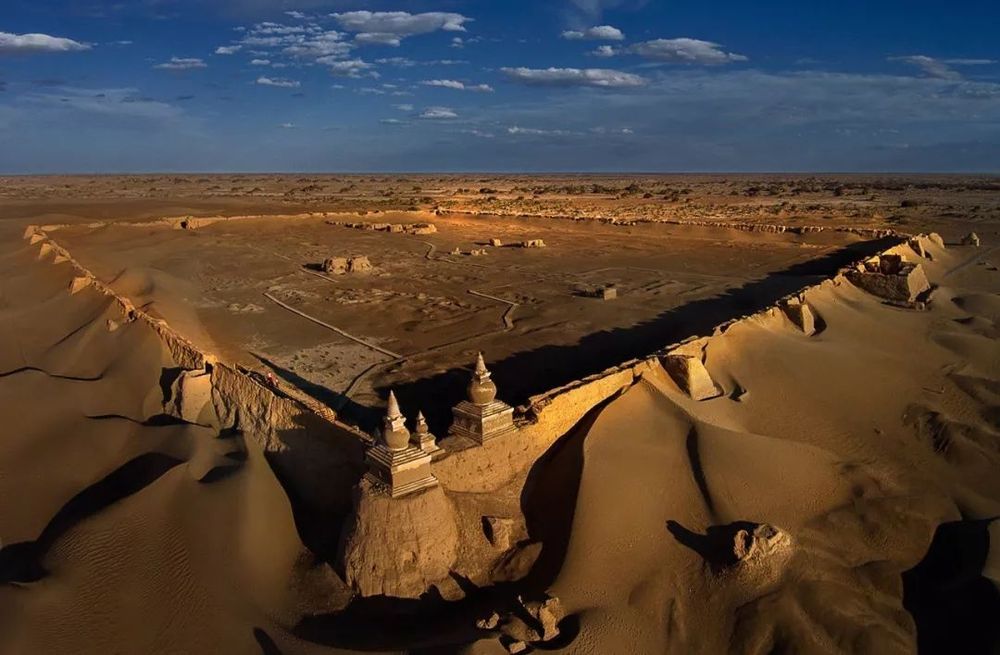Khara-Khoto: The Lost City of the Gobi Desert

Hidden deep within the vast Gobi Desert lies a haunting and mysterious sight—the ruins of Khara-Khoto. This ancient city, also known as "Black City," is a testament to the rise and fall of civilizations, standing as a silent witness to the passage of time. Located in present-day Mongolia, the ruins of Khara-Khoto beckon adventurers and history enthusiasts to unravel its enigmatic past.
Khara-Khoto was once a thriving and prosperous city during the height of the Western Xia Empire in the 11th century. It served as the capital of this long-lost civilization, nestled along the Silk Road, a vital trade route connecting East Asia with the rest of the world. The city thrived as a bustling hub of commerce, culture, and knowledge.
The name "Khara-Khoto" translates to "Black City" in the Mongolian language, derived from the dark color of the ruins. The origins of the city's abandonment and subsequent ruin remain shrouded in mystery. It is believed that Khara-Khoto fell victim to a combination of factors, including invasions, conflicts, and ecological changes in the region.
During the 13th century, the Mongol Empire under Genghis Khan began its rapid expansion, sweeping across vast territories. Khara-Khoto faced the wrath of Mongol forces, and its once-thriving civilization was subjected to destruction and desolation. The city's downfall accelerated with subsequent invasions, including those by the Yuan Dynasty and the Ming Dynasty.
The remote location of Khara-Khoto, surrounded by arid desert, contributed to its isolation and eventual abandonment. Over time, shifting sand dunes swallowed the structures, preserving them beneath the surface until their rediscovery in the early 20th century. Expeditions led by Russian archaeologist Pyotr Kozlov in 1908 uncovered the hidden ruins, unearthing a treasure trove of historical artifacts and insights into the ancient Western Xia Empire.
The ruins of Khara-Khoto offer a glimpse into a bygone era. Exploring the site reveals the remnants of a once-thriving city, with crumbling walls, broken pottery, and fragments of ancient sculptures scattered amidst the sandy landscape. The city's layout reflects its strategic importance, with remnants of defensive walls, gates, and watchtowers that once guarded its inhabitants.
One of the most remarkable discoveries at Khara-Khoto was a vast library of manuscripts. These invaluable texts shed light on the cultural and intellectual pursuits of the Western Xia Empire. The manuscripts, written in various languages, including Chinese, Tibetan, and Uighur, provide insights into the empire's religion, governance, literature, and daily life. They serve as a crucial link to understanding the history and culture of a civilization lost to time.
The ruins of Khara-Khoto continue to fascinate and captivate researchers, archaeologists, and history enthusiasts. Ongoing excavations and preservation efforts aim to unravel the secrets hidden within this forgotten city, offering a glimpse into the lives of its inhabitants and the interconnectedness of ancient civilizations along the Silk Road.
Visiting the ruins of Khara-Khoto is an extraordinary experience, taking travelers on a journey through time. Amidst the vast emptiness of the desert, the site's haunting beauty and historical significance leave a lasting impression. It serves as a poignant reminder of the transience of human existence and the impermanence of even the mightiest civilizations.
As the ruins of Khara-Khoto stand silently, bearing the weight of centuries, they invite us to contemplate the rise and fall of civilizations and the enduring legacy of those who came before us.
Above Photo: Twitter
Khara-Khoto: The Lost City of the Gobi Desert

Four of the five Yuan dynasty stupas sited on top of the northwest corner of the walls of Kharakhoto. Photo: Yeoh Thean Kheng/Flickr
Khara-Khoto: The Lost City of the Gobi Desert

The mosque at the southeast corner of Kharakhoto, circa 1914. Photo: Aurel Stein/Wikimedia
Khara-Khoto: The Lost City of the Gobi Desert

Stacks of mud bricks for repair work outside the south wall of Kharakhoto. Photo: BabelStone/Wikimedia
Khara-Khoto: The Lost City of the Gobi Desert

Photo: Fandorine1959/Wikimedia
Comments
Post a Comment